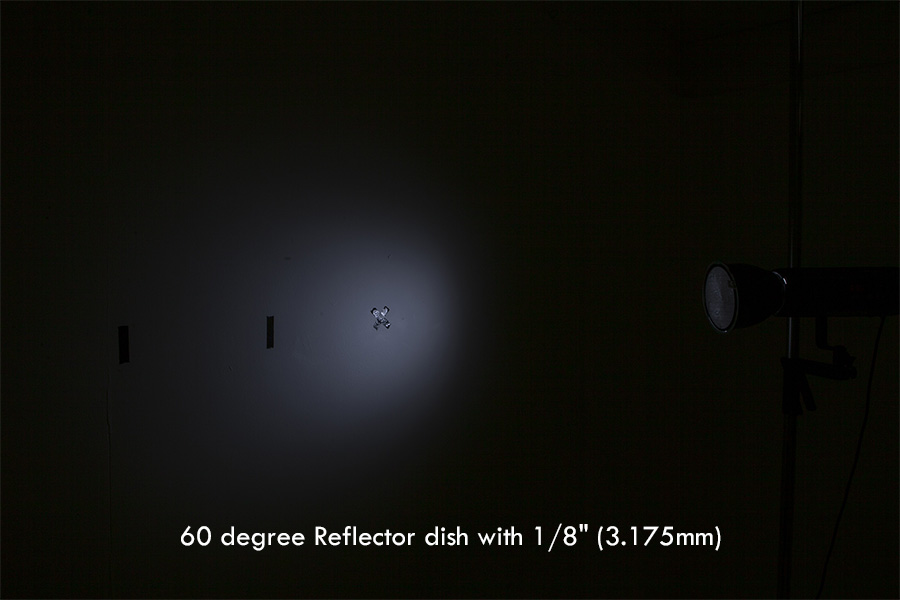I had an hour or so spare in the studio the other day whilst waiting for a client so I thought I'd have a quick look at the light fall-off of some of my attachments. Why would I bother doing this you ask? Well its not quite as ridiculously geeky as it first sounds. We all need to know our equipment and for those of us that have been shooting a specific camera for years will tell you, it becomes an extension of yourself and you could happily operate it in the dark because we know it so well. The same theory should really apply to all the equipment you own and you're probably going to have your lighting kit a lot longer than your camera so it's a great idea to find out exactly how its responding. As a result you will have a better understanding of light and how you can control it and with this knowledge it will mean you can easily pre-visualise how a set-up will look and more importantly you will have a better idea of whats going wrong if the resulting image isn't looking right.
Lighting set up lighting fall-off test
The experiment was set up like this, the strobe was locked off and wasn't moved throughout, it was angled at 45 degrees to the wall or 135 degrees, however you want to look at it. The flash was set to a constant power throughout the test and the camera settings were also fixed at ISO 100, 1/160 second at f16.
Clicking on the images below will enlarge them.
The results
The findings were measured like this, everything was set and unchanged throughout, the only adjustments were the actual swopping of attachments. A light meter reading was taken at point X on the wall and at both point I's on the wall also. The resulting fall-off of light was recorded with a light meter at each of these points and recorded.
Data reads as follows - Attachment Name - Reading at Point X - Reading at first Point I - Reading at second point I - Total number of stops of light fall-off
- Large 21" Beauty Dish with diffusion cover - f8 - f6.2 - f5.2 - Total of 1.25 stops of fall-off
- Small 15" Beauty Dish no diffusion cover - f15 - f10 - f7.3 - Total of 1 stop of fall-off
- 65 degree deep reflector dish - f12 - f9.5 - f8 - Total of 1 stop of fall-off
- Small Soft-box - f8 - f6.7 - f5.6 - Total of 1 stop of fall-off
- 120 degree wide angle reflector - f8.7 - f7.3 - f6.2 - Total of 1 stop of fall-off
- 15 degree Snoot - f5.6 - f4.8 - f3.4 - Total of 1.25 stops of fall-off
- 60 degree reflector dish - f9.5 - f8 - f6.7 - Total of 1 stop of fall-off
- 60 degree reflector dish with 1/8" grid - f8 - f4.8 - f2.8 - Total of 3 stops of fall-off
- 60 degree reflector dish with 1/4" grid - f8 - f5.6 - f4 - Total of 2 stops of fall-off
- Large Soft-box - f8.7 - f6.7 - f5.6 - Total of 1.25 stops of fall-off
Clicking this spreadsheet will enlarge it
So apart from that being an excuse to finally use a spreadsheet what purpose did it actually achieve? Well it was pretty much as I expected but it was interesting to see the brightest and darkest attachments for the same power output. The 65 degree deep dish outputting the most power over the 15 degree snoot loosing the most. It's also easy to see on the chart above how they all drop off over distance with the most aggressive clearly being the grids. There were a couple of things I did learn though, the grids were far more controlled than I had originally anticipated. I actually thought the snoot might of had more control of the light than it did and in the chart above you can see its fall-off of light is a lot more gradual than I first thought. The other thing that struck me was how much fall-off of light the big soft box produced. It actually had 1.25 stops of fall-off compared to the small soft-boxes 1 stop. In reality you'd think that a large open spread of light like that would have a consistent reading throughout the 24" range and as a result I took multiple readings because I was sure it was wrong. The only thing I can reasonably surmise from this is that at close range like this (36") the large soft-box does not have time to spread and on further inspection I realised that it did not have an internal baffle to further scatter the light. So as weird as this sounds, at close range in its current baffle-less state you would actually get a more uniform and softer light from the small soft-box.
If you have a quick half hour I do recommend trying this experiment with your own attachments, yes its pretty nerdy but it will definitely help you better understand your kit and it may even show you something you weren't expecting as it did for me (and yes I'm pretty sure a spreadsheet of your findings is mandatory).












